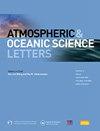Trends and characteristics of global CH4 emissions: Insights from UNFCCC greenhouse gas inventories
IF 3.2
4区 地球科学
Q3 METEOROLOGY & ATMOSPHERIC SCIENCES
引用次数: 0
Abstract
The trends and characteristics of global CH4 emissions were analyzed using greenhouse gas data reported by both Annex I and non-Annex I countries under the United Nations Framework Convention on Climate Change (UNFCCC) from 1990 to 2021. The results show the following: (1) In 2021, the cumulative CH4 emissions from the 42 nations listed in Annex I of the UNFCCC amounted to 1871521.79 kt CO2 eq. The top 10 countries account for 82.0 % of the total CH4 emissions. (2) Most Annex I countries showed a gradual decline in CH4 emissions over the period. In contrast, emissions from non-Annex I countries have increased year by year. Notably, CH4 emissions in the United States, the European Union, the Russian Federation, and Ukraine decreased by 14.0 %, 37.4 %, 24.0 %, and 60.9 %, respectively. (3) In 2020, the CH4 emissions of the agriculture, energy, waste treatment and LULUCF (land use, land-use change and forestry) sectors in Annex I countries were 72240.43, 63863.51, 41573.08, and 889019 million tons of CO2 eq, accounting for 38.6 %, 34.1 %, 22.2 %, and 4.8 %, respectively. Among non-Annex I countries, the main CH4 sources vary by country. In China and Mexico, energy and agriculture were the largest contributors, accounting for 44.8 % and 40.2 % in China, and 34.4 % and 43.3 % in Mexico, respectively. In India, Brazil, Nigeria, Argentina, and Vietnam, agriculture dominated, contributing 73.8 %, 75.8 %, 59.7 %, 60.3 %, and 58.5 % of total emissions, respectively. Indonesia was an exception, with waste treatment being the primary source, accounting for 64.8 % of its total CH4 emissions.
摘要
基于《联合国气候变化框架公约》 (UNFCCC) 附件一国家提交的 1990 年至最新清单年份 (2021 年) 温室气体排放数据, 探讨了附件一和非附件一国家排放现状, 演变趋势和关键排放源. 结果表明: 2021年UNFCCC附件一中42个国家CH4总排放量为1871521.79 kt CO2当量. 排在前10位的国家占CH4总排放量的82.0 %. (2)大多数附件一国家的CH4排放量呈逐渐下降趋势, 非附件一国家的CH4排放量呈逐年增加趋势, 其中最大的排放源的美国, 欧盟(公约), 俄罗斯联邦和乌克兰排放量分别下降了13.96 %, 37.44 %, 24.01 %和60.89 %. 乌克兰, 英国, 意大利和罗马尼亚与1990年相比, 2021年的排放量减少了60 %以上. (3) 2020年, 附件一国家农业, 能源, 废物处理和LULUCF行业的CH4排放量分别为72240.43, 63863.51, 41573.08和889.19亿吨CO2当量, 占比分别为38.60 %, 34.11 %, 22.21 %和4.75 %. 在UNFCCC非附件一国家中, 能源和农业部门是中国和墨西哥最主要的CH4排放源, 分别占中国总排放量的44.77 %和40.23 %, 占墨西哥总排放量的34.44 %和43.29 %. 在印度, 巴西, 尼日利亚, 阿根廷和越南, 农业部门是最主要的排放源, 分别占总排放量的73.75 %, 75.78 %, 59.66 %, 60.29 %和58.47 %. 印度尼西亚以废物处理部门为主, 占总排放量的64.79 %.

全球甲烷排放的趋势和特征:来自《联合国气候变化框架公约》温室气体清单的见解
利用《联合国气候变化框架公约》附件一和非附件一国家1990 - 2021年报告的温室气体数据,分析了全球CH4排放的趋势和特征。结果表明:①《联合国气候变化框架公约》附件一所列42个国家2021年CH4累计排放量为1871521.79 kt CO2当量,排在前10位的国家占CH4总排放量的82.0%。(2)在此期间,大多数附件一国家的CH4排放量呈逐渐下降趋势。相比之下,非附件一国家的排放量逐年增加。值得注意的是,美国、欧盟、俄罗斯联邦和乌克兰的CH4排放量分别下降了14.0%、37.4%、24.0%和60.9%。(3) 2020年,附件一国家农业、能源、废物处理和LULUCF(土地利用、土地利用变化和林业)部门的CH4排放量分别为7224.43、63863.51、41573.08和889.19亿吨CO2当量,占比分别为38.6%、34.1%、22.2%和4.8%。在非附件一国家中,甲烷的主要来源因国家而异。在中国和墨西哥,能源和农业是最大的贡献者,分别占中国的44.8%和40.2%,墨西哥的34.4%和43.3%。在印度、巴西、尼日利亚、阿根廷和越南,农业占主导地位,分别占总排放量的73.8%、75.8%、59.7%、60.3%和58.5%。印度尼西亚是一个例外,废物处理是主要来源,占其CH4总排放量的64.8%。摘要基于“联合国气候变化框架公约”(UNFCCC)附件一国家提交的1990年至最新清单年份(2021年)温室气体排放数据,探讨了附件一和非附件一国家排放现状,演变趋势和关键排放源。结果表明:2021年《联合国气候变化框架公约》附件一中42个国家CH4总排放量为1871521.79 kt二氧化碳当量。82.0%。(2)大多数附件一国家的CH4排放量呈逐渐下降趋势,非附件一国家的CH4排放量呈逐年增加趋势,其中最大的排放源的美国,欧盟(公约),俄罗斯联邦和乌克兰排放量分别下降了13.96%,37.44%,24.01%和60.89%。乌克兰, 英国, 意大利和罗马尼亚与1990年相比, 2021年的排放量减少了60 %以上. (3) 2020年,附件一国家农业,能源,废物处理和LULUCF行业的CH4排放量分别为72240.43,63863.51,41573.08和889.19亿吨二氧化碳当量,占比分别为38.60%,34.11%,22.21%和4.75%。在《联合国气候变化框架公约》非附件一国家中,能源和农业部门是中国和墨西哥最主要的CH4排放源,分别占中国总排放量的44.77%和40.23%,占墨西哥总排放量的34.44%和43.29%。在印度,巴西,尼日利亚,阿根廷和越南,农业部门是最主要的排放源,分别占总排放量的73.75%,75.78%,59.66%,60.29%和58.47%。64.79%。
本文章由计算机程序翻译,如有差异,请以英文原文为准。
求助全文
约1分钟内获得全文
求助全文
来源期刊

Atmospheric and Oceanic Science Letters
METEOROLOGY & ATMOSPHERIC SCIENCES-
CiteScore
4.20
自引率
8.70%
发文量
925
审稿时长
12 weeks
 求助内容:
求助内容: 应助结果提醒方式:
应助结果提醒方式:


